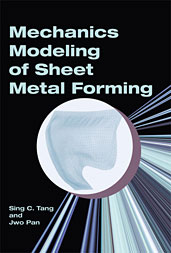Journal Article
Failure Mode and Fatigue Behavior of Flow Drill Screw Joints in Lap-Shear Specimens of Aluminum 6082-T6 Sheets Made with Different Processing Conditions
2018-04-03
2018-01-1237
Failure mode and fatigue behavior of flow drill screw (FDS) joints in lap-shear specimens of aluminum 6082-T6 sheets made with different processing conditions are investigated based on the experimental results and a structural stress fatigue life estimation model. Lap-shear specimens with FDS joints without clearance hole and lap-shear specimens with stripped FDS joints with clearance hole were made and then tested under quasi-static and cyclic loading conditions. Optical micrographs show the failure modes of the FDS joints without clearance hole (with gap) and the stripped FDS joints with clearance hole under quasi-static and cyclic loading conditions. The fatigue failure mode of the FDS joints without clearance hole (with gap) in lap-shear specimens is similar to those with clearance hole. The fatigue lives of lap-shear specimens with FDS joints without clearance hole are lower than those with clearance hole for given load ranges under cyclic loading conditions.

